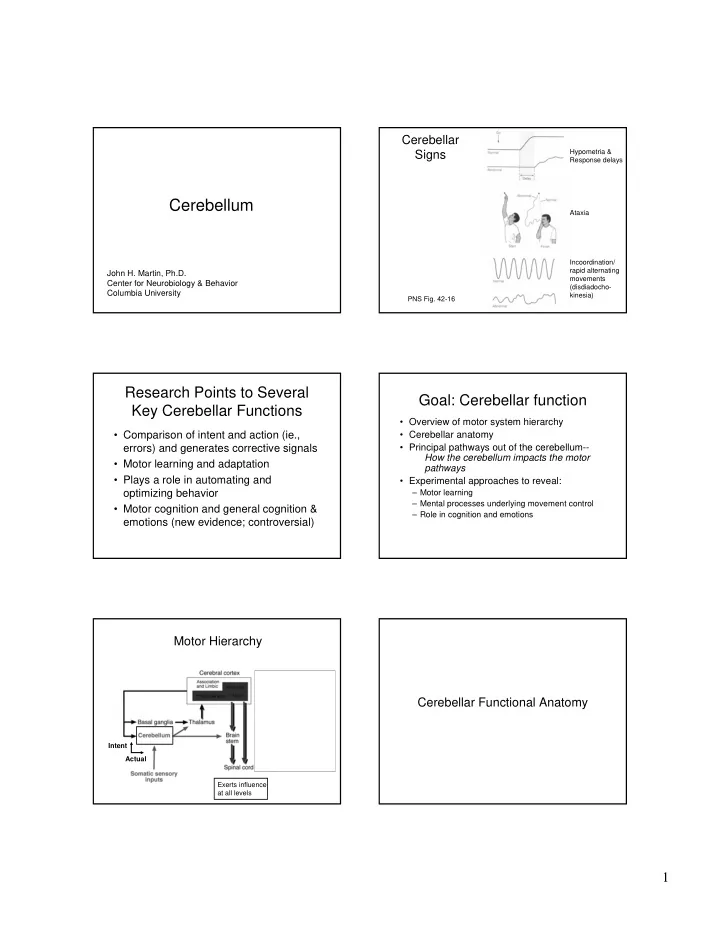

Cerebellar Hypometria & Signs Response delays Cerebellum Ataxia Incoordination/ rapid alternating John H. Martin, Ph.D. movements Center for Neurobiology & Behavior (disdiadocho- Columbia University kinesia) PNS Fig. 42-16 Research Points to Several Goal: Cerebellar function Key Cerebellar Functions • Overview of motor system hierarchy • Comparison of intent and action (ie., • Cerebellar anatomy • Principal pathways out of the cerebellum-- errors) and generates corrective signals How the cerebellum impacts the motor • Motor learning and adaptation pathways • Plays a role in automating and • Experimental approaches to reveal: optimizing behavior – Motor learning – Mental processes underlying movement control • Motor cognition and general cognition & – Role in cognition and emotions emotions (new evidence; controversial) Motor Hierarchy 1° Som sensory Cerebellar Functional Anatomy Intent Actual Exerts influence at all levels 1
Input-output Organization Deep Cerebellar Nuclei: Fastigial Cerebellar cortex Interposed Dendate + Cerebellar Cortex Cortex + - Deep Cerebellar Nuclei: Nuclei Dentate + Output Interposed Vestibular Fastigial nuclei Extrinsic inputs: mossy fiber climbing fiber PNS Fig. 42-1 NTA Fig. 13-2,4 Cerebellar Cortex Cerebellar divisions Inputs Climbing fibers Spinocerebellum: •from Inferior olive Vermis Spinocerebellum Mossy fibers Intermediate hem. (Vermis + Intermed. Hem) Cerebrocerebellum: Output Lateral hem. Control of limbs Purkinje neurons and trunk Interneurons Cerebrocerebellum Granule neurons (Lateral hemisphere) Planning of movement+ Stellate neurons Vermis IV th vent Vestibulo-cerebellum Intermediate hem. Basket neurons (Floculo-nodular lobe) Lateral hem. Golgi neurons Molecular Control of eye & Purkinje head movements Granular Balance NTA Fig. 13-1 NTA Fig. 13-11 Floculo-nodular lobe Functional divisions of cerebellar cortex --> Deep nuclei Without inhibitory circuits With inhibitory circuits Inhibition reduces size of active Purkinje neurons = Lateral inhibition Output more focused; more precise Parallel fiber input to cerebellar cortex PNS Fig. 42-2 2
Functional divisions of cerebellar cortex --> Deep nuclei Medial & lateral systems Spinocerebellum Interposed nuclei Vermis Intermediate hemisphere Spinocerebellum Vermis Cerebrocerebellum Fastigial Intermediate hem Lateral hemisphere Cerebrocerebellum Lateral hemisphere Vestibulocerebellum Inter via vestibular nuclei Dentate posed Fastigial Vestibulo- cerebellum Vestibulo- cerebellum Floculo-nodular lobe To frontal To To To motor areas lateral medial vestibular sysetms sysetms nuclei Motor Motor Eye mvt & Planning execution balance PNS Fig. 42-3 NTA Fig. 10-2 +++ NTA Fig. 13-1 Intermediate and Lateral Vermis & Vestibulocerebellum Hemispheres Functions of the Cerebellum Planning and Thalamus and limb control Cortical motor areas Brain stem nuclei • Motor learning/adaptation Cerebellar cortex & Deep nuclei • Non-motor functions: – Active tactile exploration Brain stem nuclei Axial control – Higher brain functions (cerebellar cognitive- affective syndrome) PNS Fig. 42-10, 12 Ipsilateral Bilateral Non-motor Function Motor Passive stimulation Discriminate roughness Learning Before Before Prisms Prisms After After Manipulate only Manipulate + discriminate PNS Fig. 42-15 PNS Fig. 42-14 3
Cerebellar Cognitive Affective Cerebellar Motor Functions Disorder • Implemented via lateral and medial pathways, • Lesions of the posterior cortex and vermis especially the corticospinal tract • Impairment of executive functions • Incorporated into motor programs via frontal motor areas (SMA, premotor cortex…) – Planning, verbal fluency, abstract reasoning • Becomes part of motor strategy via prefrontal cortex • Difficulties with spatial cognition – Visuo-spatial organization, visual memory • Personality changes – Blunting of affect, inappropriate behaviors • Language disorders – Agrammatism Conclusions • Cerebellar lesions produce – Incoordination & errors not weakness – Lose ability to anticipate errors – Lose ability to correct • Motor learning – Requires sensory awareness – Implemented via the descending cortical and brain stem pathways • Cognitive and emotional disturbances – Anatomical connections to prefrontal and cingulate cortex (via thalamus) • No single function – Clearly mostly motor; learning, optimizes – Functions may apply to cognitive and emotional behaviors 4
Recommend
More recommend